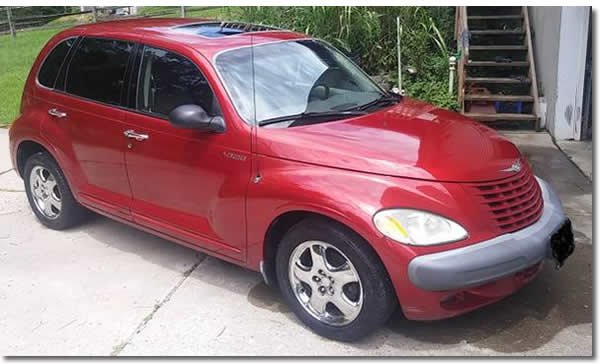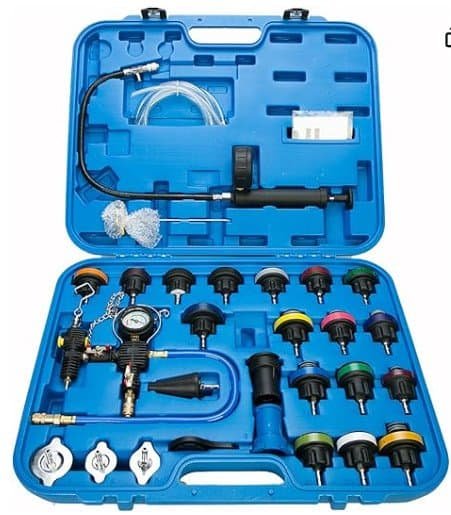
2002 PT Cruiser radiator problems. Overheating after just a few miles, never have seen a leak but have added a lot of antifreeze (like 2-3 gal). This is what I’ve done so far. Antifreeze , thermostat, cap -cuz seal was broken. Heat works sometimes, but it does overheat at about 3-4 miles. I’ve heard some scary sounds, but its rare. I’m a girl but do know cars…brakes, distributor caps, alternators, etc. But on cars newer then 1980’s fuel injection, don’t know to much.
Could it be water pump? Just not sure what to do. Also, front windows don’t work anymore, rear windows are fine and all the fuses are fine.
Thank you so much, any guidance would be great!
Radiator problems
Since you are loosing anti-freeze that would be the first thing to figure out. You will need to pressure test the cooling system to determine if and where the leak is coming from. It can leak externally or internally. And also determine if the radiator cooling fan is coming on as it should.
That being said, it is important that the antifreeze that you added was 50/50 mix. If you add straight water or straight antifreeze it can and will overheat quickly. Therefore antifreeze and water mixed together offer a higher boiling point.
Pressure testing the cooling system
Top off cooling system. Acquire a cooling system pressure tester and connect it to the radiator in place of the cap. Pump up the pressure to around 15 psi and allow it to hold for 15 minutes. Look underneath and around the engine bay for signs of leaking coolant/antifreeze. If the pressure drops rapidly then you know there is a large leak and should be fairly easy to locate. In addition, a slow drop may be more difficult to locate the leak. Placing a clean piece of cardboard under the car may assist in locating the leak.
Internal coolant leak
If you see the pressure drop quickly on the pressure tester without any signs of external leaking you are left with and internal leak. Internal leaks generally cause a noticeable performance issue such as an engine misfire. Finally you may also see the check engine light come on.
Cooling System Bleeding
Air can only be removed from the system by gathering under the radiator cap. On the next engine heat up cycle, the air is pushed past the radiator cap into the coolant recovery bottle by thermal expansion of the coolant. The air then escapes to the atmosphere in the coolant recovery bottle and is replaced with coolant on cool down. To effectively deaerate the system, multiple thermal cycles of the system may be required. Deaeration does not occur at engine idle. Higher than engine idle speeds are required. Normal driving will deaerate the cooling system.
Technical Information:
Anti-freeze Desription
Coolant flows through the engine water jackets and cylinder heads absorbing heat produced by the engine during operation. The coolant carries heat to the radiator and heater core. Here it is transferred to ambient air passing through the radiator and heater core fins.
The required ethylene-glycol (antifreeze) and water mixture depends upon the climate and vehicle operating conditions. The recommended mixture of 50/50 ethylene-glycol and water will provide protection against freezing to -37 deg. C (-35 deg. F). The antifreeze concentration must alwaysbe a minimum of 44 percent, year-round in all climates. If percentage is lower than 44 percent, engine parts may be eroded by cavitation, and cooling system components may be severely damaged by corrosion.Maximum protection against freezing is provided with a 68 percent antifreeze concentration, which prevents freezing down to -67.7 deg. C (-90 deg. F). A higher percentage will freeze at a warmer temperature. Also, a higher percentage of antifreeze can cause the engine to overheat because the specific heat of antifreeze is lower than that of water.
100 Percent Ethylene-Glycol—Should Not Be Used in Chrysler Vehicles
Use of 100 percent ethylene-glycol will cause formation of additive deposits in the system, as the corrosion inhibitive additives in ethylene-glycol require the presence of water to dissolve. The deposits act as insulation, causing temperatures to rise to as high as 149 deg. C (300 deg. F). This temperature is hot enough to melt plastic and soften solder. The increased temperature can result in engine detonation. In addition, 100 percent ethylene-glycol freezes at -22 deg. C (-8 deg. F ).
Propylene-glycol Formulations—Should Not Be Used in Chrysler Vehicles
Propylene-glycol formulations do not meet Chrysler coolant specifications.It’s overall effective temperature range is smaller than that of ethylene-glycol. The freeze point of 50/50 propylene-glycol and water is -32 deg. C (-26 deg. F). 5 deg. C higher than ethylene-glycol’s freeze point. The boiling point (protection against summer boil-over) of propylene-glycol is 125 deg. C (257 deg. F ) at 96.5 kPa (14 psi), compared to 128 deg. C (263 deg. F) for ethylene-glycol. Use of propylene-glycol can result in boil-over or freeze-up in Chrysler vehicles, which are designed for ethylene-glycol. Propylene glycol also has poorer heat transfer characteristics than ethylene glycol. This can increase cylinder head temperatures under certain conditions.
Propylene-glycol/Ethylene-glycol Mixtures—Should Not Be Used in Chrysler Vehicles
Propylene-glycol/ethylene-glycol Mixtures can cause the destabilization of various corrosion inhibitors, causing damage to the various cooling system components. Also, once ethylene-glycol and propylene-glycol based coolants are mixed in the vehicle, conventional methods of determining freeze point will not be accurate. Both the refractive index and specific gravity differ between ethylene glycol and propylene glycol.
Caution:
Richer antifreeze mixtures cannot be measured with normal field equipment and can cause problems associated with 100 percent ethylene-glycol.
